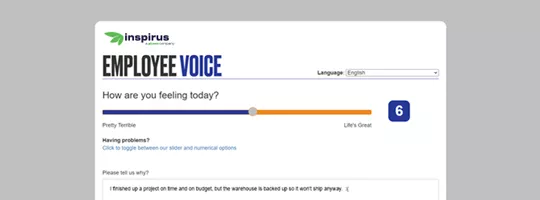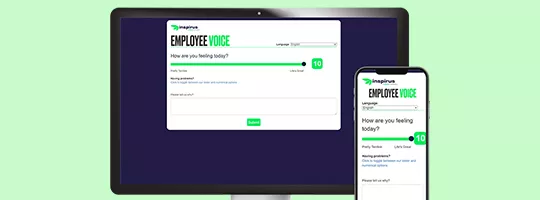Hard data and quantitative KPIs are nothing new for organizations – the most successful companies carefully measure and track all aspects of business performance.
To improve and grow, you have to know what the baseline is.
The same data-driven approach is a key way to support your most valuable asset: your people. How can you measure job satisfaction, work-life balance, team collaboration and the overall employee experience? Employee feedback surveys are a great place to start.
Feedback is a cornerstone for growth and development. And to be effective, it has to be a two-way street. That means it’s not just about giving employees feedback on their performance.
To really drive organizational success, employees need to be able to share their thoughts at every stage of their journey, from employee training feedback surveys to ongoing employee satisfaction assessments right through to exit interviews.
Click here to learn how Connects adds employee feedback surveys for one unified solution.
The Significance of Employee Feedback

A company’s performance is directly linked to how well the organization’s employees are doing. The importance of employee feedback surveys and engagement surveys cannot be overstated.
That’s because engaged, motivated employees do better work and are less likely to leave. Job satisfaction and a positive work environment are driving forces behind any company’s success. This is true across industries, sectors and job positions.
In fact, employee engagement can improve productivity and performance on the job by 14 percent, according to Deloitte. Likewise, Gallup found that highly engaged business units achieve a 10 percent difference in customer ratings and an 18 percent difference in sales.
Impactful engagement doesn’t happen by accident, though. It’s built on employees feeling valued and heard. Employee feedback surveys are a bridge connecting management with the workforce, offering a structured channel for employees to express their thoughts, opinions and concerns.
From Google’s famous “Googlegeist” survey – which, the company announced, will now be held weekly rather than annually – to regular pulse surveys from other big tech companies like Apple, Microsoft and Amazon, there’s a good reason why leading organizations make it a priority to stay tuned into employee sentiment.
Designing a Comprehensive Employee Feedback Survey
Creating an employee feedback survey that effectively captures insights and drives meaningful change requires thoughtful planning and strategy. Done right, it’s one of the best ways to create a great company culture.
Key Elements

Relevance and Alignment
Use your survey as an opportunity to address a spectrum of topics relevant to employees’ experiences. This should include looking at:
• Company culture
• Diversity, equity and inclusion
• Vision and values
• Well-being and mental health
• Training and growth opportunities
• Career development
• Recognition and rewards
• Managerial support and style

Brevity and Clarity
While it’s crucial to cover diverse aspects, the survey should remain concise and easy to understand. Lengthy or complicated surveys can lead to incomplete responses and inaccurate data.
Make it as easy as possible for employees to respond to the survey so they can provide accurate and meaningful feedback. It’s much better to have frequent, shorter surveys than one momentous annual survey.

Impact
The employee voice is powerful, but it needs to be taken seriously for employees to truly feel like they are being heard. Simply surveying employees isn’t enough to improve company culture; concrete actions need to be taken based on the insights gathered to create a culture of employee feedback.

Factors To Consider When Crafting Survey Questions
The best survey questions for employee feedback are thoughtful and fit into an overarching engagement strategy. When crafting the bones of a survey, pay attention to the questions you’re asking and how they are phrased.
- Be specific: Rather than asking general questions about job satisfaction, focus on areas like workload, recognition and professional development. Being specific helps elicit actionable insights.
- Avoid bias: Neutral language and balanced options prevent leading respondents towards a particular response. Instead of asking, “Do you agree that our communication is effective?” phrase it as, “How would you rate the effectiveness of communication within your team?”
- Offer a mix of question types: Include open-ended questions in addition to other response formats like multiple-choice, sliding scale or Likert scales questions.

Tips for Choosing Appropriate Survey Scales and Response Formats
There’s no one right answer for what type of survey response format is best, but there are two key factors to keep in mind:
- Do the questions solicit enough detail to be useful?
- Are the answers anonymous or can they be traced back to the employee?
Including a mix of different question types, as mentioned above, and keeping the answers anonymous helps garner valuable employee insights that can be addressed right away.
Implementing the Survey Process
Once you know what you want to ask, how you plan to survey employees and what you’ll do with the data, it’s a simple matter of implementing the survey process. That is – it can be simple if administered strategically.
Using a digital employee platform rather than paper-based forms is the easiest way to gather the answers you need. Especially with remote and hybrid workforces, or companies larger than just a few people, leveraging the right technology can make all the difference.
A solution like Inspirus Connects Plus has integrated digital survey tools to make it easy to gain insight into employee sentiment. In partnership with The Happiness Index, more than a dozen pre-built surveys are available to help you better understand opportunities for improvement without needing to reinvent the wheel.
From there, you also need to decide how frequently to run the employee survey feedback sessions. Many companies run an annual survey, but that really isn’t often enough to keep a finger on the pulse. Instead, collect feedback in real-time so you can identify any issues as they arise.
Finally, it’s important to make sure that the answers are kept anonymous and confidential to encourage honest responses without fear of reprisals.
So, to recap:
- Leverage technology
- Collect real-time feedback
- Tap into pre-built surveys
- Keep answers anonymous

Encouraging Participation
Encouraging active employee participation in the feedback process is essential to gather a diverse range of perspectives and insights.
The average employee survey response rate for organizations with fewer than 500 employees is around 85 percent. For larger organizations with more than 5,000 employees, that rate drops down to about 65 percent.
Make sure to clearly communicate the purpose, benefits and expected outcomes of the survey. Explain to employees how their feedback will be used to drive positive changes and emphasize that every opinion matters. If the answers will be anonymous, highlight the confidentiality measures in place to address any privacy concerns, ensuring that employees feel comfortable sharing their thoughts openly.
For the most critical of surveys, consider offering incentives like gift cards or other rewards to encourage employees to participate and show appreciation for their input.
Collecting and Analyzing Feedback
Collecting and analyzing employee feedback is where the insights gained from the survey truly come to life. Think about the different surveys you may run by topic: workplace culture, DEI, well-being and mental health, vision and values, and so on. This helps keep surveys focused while also making it easier to later analyze the data.
Using an integrated tool like Inspirus Connects Plus streamlines the process of both collecting and analyzing feedback about all these topics. There are more than a dozen employee survey feedback examples to choose from like:
Employee Voice
Measure happiness and engagement, empowering employees to share feedback anonymously any time of day or night.
Recognition Impact Index
Assess your organization’s cultural health by benchmarking engagement and happiness indicators.
Cultural Assessment Survey
Get a baseline measurement of your company’s cultural health.
Values Index Survey
See how aligned employees feel with your organization’s vision and values.
Equality of Voice Survey
Better understand diversity, equality and inclusion within your organization.
Advancing Racial Equity Survey
Encourage employees to share their feedback on key racial and diversity topics at the company.
Remote Working Survey
Monitor how employees feel about the current culture and how it is changing.
Keeping employee feedback surveys in one unified solution simplifies tracking the data over time and pulling out key insights that will elevate company culture.
For instance, with the survey dashboard through Connects, administrators can see all survey insights in one place including cross-themed analysis, heatmaps, sentiment analysis, and key driver analysis.
Monitoring Progress and Continuous Improvement
Effective employee feedback initiatives don’t stop with data collection or analysis – it’s a cyclical process that underpins an overarching commitment to continuous improvement.
After implementing changes based on feedback, leaders and managers should then circle back to the survey to gauge the impact of those changes over time. Employee needs and sentiments are constantly evolving, so it’s important to remain responsive.
Use the insights gained from tracking change impact to fine-tune strategies and initiatives. If certain changes yield positive results, consider scaling them across the organization. Or, if it doesn’t have the desired effect, solicit further feedback.
Conduct follow-up surveys, offer a way for employees to provide anonymous feedback 24/7 and embrace an iterative approach to continuously improving the overall employee experience.
Inspirus and The Happiness Index Partnership For More Insights
As organizations deal with new challenges in retention, burnout and digital workforces, it is essential to measure both happiness and engagement for cultural and business success, as well as the overall health of employees.
Inspirus has partnered with The Happiness Index (THI) to offer organizations a unified technology platform that delivers a pioneering combination of employee recognition, feedback, engagement and happiness.
Using insights uncovered by neuroscience, THI measures people on four criteria; instinctive, emotional, reflective and rational. These provide an overall score of an employee’s happiness and engagement, that when measured and optimized, will provide not only a thriving workplace environment, but a happier, more productive employee. By delving into neuroscience, THI helps you understand the deeper emotions and motivations of your workforce.
What does this look like in practice? Surveys include:
- Recognition Impact Index: Fourteen neuroscience-backed questions collect quantitative and qualitative data to help nurture a happier, more engaged workforce.
- Employee Voice: Employees can give feedback how, when and where they want on topics from remote work to well-being to diversity.
- Plus more pre-built surveys!
FAQ’s About Employee Feedback
Why are employee feedback surveys important?
Employee feedback surveys provide a structured way to gather insights directly from employees, enabling organizations to understand their sentiments, needs and concerns. This data can then be used to improve engagement, job satisfaction and overall organizational performance.
How often should we conduct employee feedback surveys?
The optimal frequency of employee feedback surveys depends on several factors, including your organizational dynamics and the pace of change. That said, annual or bi-annual surveys are rarely sufficient.
Quarterly surveys are common and can strike a balance between maintaining regular communication and preventing survey fatigue. Frequent surveys that capture real-time insights are the best fit for most organizations, allowing for issues to be addressed promptly.
How can we ensure employees’ anonymity and confidentiality in surveys?
Employ methods like third-party survey administrators, encrypted data storage and aggregation of results to ensure anonymity and confidentiality.
Clearly communicate these measures to employees in the survey introduction, assuring them that their responses are anonymous to encourage honest, uninhibited responses.
What steps should we take after collecting feedback to drive improvement?
After collecting and analyzing feedback, the next step is to transform the data into actionable insights.
Identify recurring themes and areas for improvement, then prioritize these based on their impact on employee engagement and satisfaction.
Regularly track the impact of these changes using metrics such as engagement scores, turnover rates and performance indicators.
Other Valuable Resources on Employee Feedback

What Employee Feedback Can Tell You

Using Employee Feedback to Create a Great Company Culture
